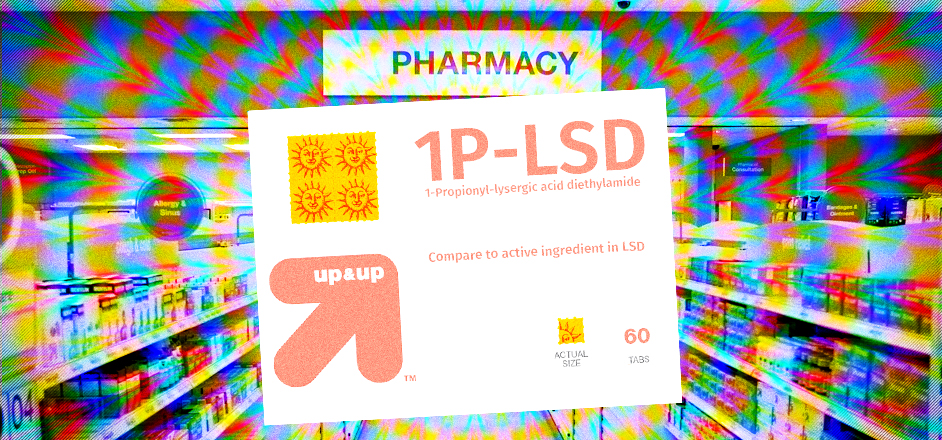In an economy that's increasingly counterfeit, there are knockoff designer Gucci handbags, knockoff designer Nikes, and knockoff designer Rolexes. They look nearly identical to the real items and perform all the same functions, but at a fraction of the cost.
The latest craze in imitation products is designer drugs, knockoff alternatives of various mind-altering substances. Often cheaper and more legal, they've become widely available to anyone with a credit card and an Internet connection.
Things like LSD and magic mushrooms are currently Schedule I narcotics. Prescription drugs Ritalin and Xanax, although they aren’t as strictly classified, are tightly controlled by Uncle Sam all the same.
On emerging gray market drug superstores like IMDRC.com and Lysergi.com, consumers are buying knockoff chemicals to achieve the same effects of LSD, magic mushrooms, Ritalin, or Xanax without paying top dollar to see a doctor or meeting a sketchy drug dealer in a Waffle House parking lot.
To construct variants of these substances, laboratory chemists begin with a template of the narcotic, and rearrange its molecules until they create a drug that is extremely similar, yet chemically distinct from the original. This same process was performed to produce spice, synthetic cannabinoids that mimic the effects of marijuana, or mephedrone, a high-duration amphetamine.
The modifications made to these chemicals are sometimes intended to improve upon their parent drugs, increasing potency or decreasing side effects. The resulting concoction, an alternative drug that is only slightly different in composition, is commonly called an “analog.” Among the recreational drug community, a number of analogs have gained ubiquity as enhanced versions of beloved substances.
"Given the almost infinite scope to alter the chemical structure, new formulations are outpacing efforts to impose international control … "
However, alterations aren’t always about making the drugs better. Sometimes, the adjustments are intended only to make the drugs legal. In some countries, a specific molecular arrangement may be outlawed, but by tweaking the molecules just slightly — adding a couple oxygen atoms here, a couple hydrogen atoms there — the chemicals will fall outside the law.
In theory, the added oxygen and hydrogen simply disintegrates once the molecule gets into your system, and if all goes well, you'll be left with the original drug and its original psychoactive effects.
However, users report that that isn't always true; the new drugs don't always feel quite like the original, the way black-market Nikes don't quite give you Michael Jordan's ups.
Among the recreational drug community, accessible intoxicants may be a dream come true, but each designer drug’s revamping creates a nightmare for authorities. Because chemists are endlessly conjuring up novel ways to modify chemicals and get around local drug laws, new chemicals are created with such dizzying speed that anti-drug agencies simply can't keep up.
"Given the almost infinite scope to alter the chemical structure, new formulations are outpacing efforts to impose international control," claimed a report from the UN's Office of Drugs and Crime. The report asserts that in just one year, the UN's drugs office was alerted to 97 new drugs.
These substances present a real danger for users. For one, many of these chemicals need less than a pinch to produce their desired effects, leaving very little room for error. There are innumerable stories online of people misplacing the decimal point, ingesting 10 times too much, and waking up on a gurney with several doctors standing over them. What’s worse, because access is nearly effortless and no doctor or authority is monitoring your intake, it's easier to get addicted.
Americans especially love designer drugs. According to the Global Drug Survey, the world's largest survey of drug users, Americans are more likely to buy these "novel psychoactive substances" than any other country. The next biggest knockoff-drug-loving nations are the Netherlands, Scotland and the U.K.

The most sought-after highs, and the best sellers on major chemical marketplaces, are legal versions of LSD. Here, there's an abundance of options to choose from. 1P-LSD feels a lot like the original, users say. AL-LAD, some say, feels even better.
The Global Drug Survey claims that use of LSD analogs has skyrocketed. It was nearly ziltch four years ago. But by this past year, nearly 7 percent of psychedelic users had used legal cousins of LSD. After LSD, the legal, redesigned drugs in highest demand were variations of MDMA, stimulants, cannabis, benzos and opioids, in that order.
Getting your hands on any of these highs has always been a difficult and dangerous process, until designer drugs changed the game. Today, slightly tweaked alternatives to mind-altering substances are offering the same euphoria — except they’re cheap, quasi-legal and universally available.
The massive chemical marketplaces making these drugs’ proliferation possible embody an effortless and unstoppable supplier like we’ve never seen before. Patients without a prescription and nerds without a dealer are no longer stymied by these obstacles, as off-brand variations of any drug they desire can be delivered right to their doorstep.
These Internet superstores are like the Neiman Marcus of narcotics, the Dillard’s of depressants, or the Sears of stimulants. The knockoff drugs within their inventory may be second-rate merchandise with myriad hazards, but some believe those law-abiding bargains are unbeatable.



Leave a Reply
You must be logged in to post a comment.